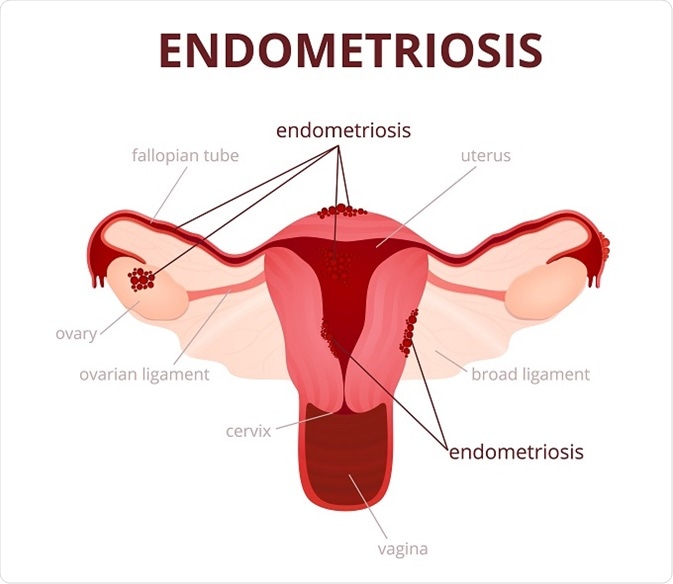
Endometriosis is a relatively common chronic disease in which endometrial-like tissue, similar to the lining of the uterus, grows and develops outside the uterus. This process usually occurs in the pelvic area, such as on the ovaries, fallopian tubes, pelvic walls, and even the intestines, but theoretically it can occur anywhere in the body. Although these growths are not cancerous, they can cause severe pain, inflammation, and sometimes severe menstrual disturbances, and can also be a cause of infertility.
The main cause of endometriosis is still not fully understood, but there are several main theories, including the backflow of menstrual blood through the fallopian tubes into the abdominal cavity, genetic factors, immune system disorders and some environmental hypotheses. Symptoms can vary widely and include menstrual pain, irregular periods, pain during intercourse, pain during defecation or urination during menstruation, as well as fertility problems.
Although endometriosis can significantly affect a woman's quality of life, with the right treatment and support, most women are able to control their symptoms and maintain a high quality of life. In addition, raising public awareness of endometriosis helps in early diagnosis and providing the necessary treatment and support.
The most common symptoms of endometriosis
Endometriosis is a complex and often recurring chronic condition in which tissue similar to the inner lining of the uterus (endometrium) grows outside the uterus. This condition causes a variety of symptoms that can significantly affect women's quality of life and health. The symptoms of endometriosis can be varied and vary from mild to very severe, depending on the location of the endometriosis growth.
- One of the most common symptoms is pain, especially during menstruation. This pain can be much more intense than normal menstrual discomfort and can interfere with daily activities. Another common problem is pain during intercourse, which can cause emotional stress and strain in relationships. In addition, endometriosis can cause chronic pelvic pain that is not associated with menstruation, which can be constant, bothersome pain.
- A common symptom of endometriosis is infertility. Although not all women with endometriosis experience infertility, the condition significantly increases the risk of such a problem. Inflammation and tissue growth caused by endometriosis can interfere with egg release, fertilization, or the movement of an egg through the fallopian tubes.
- Other symptoms include heavy or irregular periods, pain when urinating or defecating, especially during menstruation, and general fatigue, which may be associated with chronic pain or inflammation. Some women also experience other symptoms, such as bloating, sometimes called an "endobelly," and chronic fatigue that can make daily activities difficult.
The effects of endometriosis on women's health are profound and multifaceted, including physical pain, emotional stress, and relationship and fertility problems. For this reason, a complex approach to treatment is necessary, which would not only address physical discomfort, but also provide emotional and psychological support. Early diagnosis and an individual treatment plan, taking into account specific symptoms and changes in the quality of life of a woman, are essential factors in order to reduce the impact of endometriosis and improve the quality of life of sufferers.
:max_bytes(150000):strip_icc()/VWH-MiraNorian-EndometriosisSymptoms-Standard-7528f102d7664245992e87621a75ce7f.jpg)
How is endometriosis diagnosed?
Diagnosing endometriosis is a complex process that involves a variety of diagnostic methods that help assess symptoms, perform a physical examination, and ultimately confirm the diagnosis using invasive and non-invasive tests. The diagnostic pathway begins with a thorough analysis of the patient's medical history and physical examination, which help identify symptom patterns and possible signs of endometriosis.
The first step is a careful evaluation of symptoms, especially menstrual pain, infertility, and pain during intercourse. Your doctor may also perform a gynecological exam to look for any unusual lumps or growths, especially in the pelvic area. However, these methods are often not accurate enough because endometriosis foci can be very small or located in places that are difficult to reach during a standard gynecological examination.
Ultrasound examination (sonography), especially transvaginal ultrasound, is often used as a non-invasive method to detect ovarian endometriomas (known as cysts) or other abnormalities of the pelvic organs. Although this method is effective in cases of ovarian endometriosis, it may be less sensitive in detecting small foci of endometriosis or foci located outside the uterus.
Magnetic resonance imaging (MRI) can be used as an additional diagnostic tool to help evaluate the size and location of endometriosis foci in more detail, especially when deep endometriosis is suspected or to elucidate more complex pelvic structures.
Finally, laparoscopy, an invasive surgical procedure performed through small incisions in the abdomen with a video camera, is considered the "gold standard" for diagnosing endometriosis. This procedure allows you to directly see and evaluate endometriosis foci, as well as remove or take samples for biopsy. Laparoscopy not only confirms the diagnosis, but can also be used as a treatment method, removing foci of endometriosis and improving symptoms.
Although these diagnostic methods are very effective in identifying endometriosis, it is important to emphasize that due to the complexity of endometriosis and the variety of symptoms, each patient requires an individualized diagnostic and treatment plan. Early detection of endometriosis and appropriate treatment can significantly improve a woman's quality of life and reduce the health problems associated with the disease.
How does endometriosis affect female fertility and what measures can be taken?
Endometriosis is one of the main causes of female infertility, affecting about 30-50% of affected women. The effects of endometriosis on fertility are complex and may involve multiple mechanisms. First, endometriosis causes inflammation in the pelvic cavity, which can interfere with egg release, fertilization, and implantation. Second, endometriosis can physically block or damage the fallopian tubes and ovaries. In addition, endometriosis can affect the uterus by changing its shape or function, which can also make it difficult to get pregnant.
Although endometriosis can significantly reduce fertility, there are various treatments available to help women conceive. Treatment strategies depend on the severity of endometriosis, symptoms, the woman's age, and how long she has been trying to conceive.
Drug therapy
Although medications to treat symptoms of endometriosis, such as nonsteroidal anti-inflammatory drugs (NSAIDs) or hormonal agents, cannot directly improve fertility, they can be used to control symptoms, which can help a woman feel better and optimize other fertility treatments.
Surgical treatment
Laparoscopy, an invasive surgical procedure, is one of the most effective ways to treat endometriosis and can improve your chances of fertility. During this operation, the foci of endometriosis can be removed and the normal anatomy of the pelvis restored, thereby reducing inflammation and improving reproductive functions.
Artificial insemination procedures
In vitro fertilization (IVF) and other artificial insemination procedures may be recommended for women who are unable to conceive with other treatments. IVF is a particularly effective method for women with endometriosis, as fertilization takes place in the laboratory, bypassing possible mechanical obstacles and the inflammatory environment in the pelvic cavity.
Lifestyle change
Although a direct link between lifestyle changes and improved fertility in women with endometriosis is difficult to establish, a healthy diet, regular physical activity, and weight control can have a positive effect on overall health and fertility. Some studies suggest that omega-3 fatty acids and foods rich in antioxidants may have anti-inflammatory effects that could theoretically be beneficial in treating endometriosis.

Information sources
- "Endometriosis: A Key to Healing Through Nutrition"
- "Endometriosis: Science and Practice"
- The World Endometriosis Research Foundation (WERF)
# endometriozė






